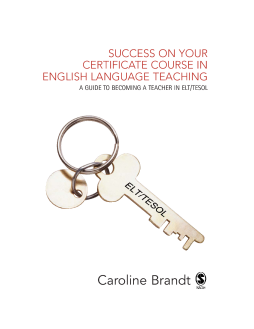
BOOK
Success on Your Certificate Course in English Language Teaching: A Guide to Becoming a Teacher in ELT/TESOL
(2006)
Additional Information
Book Details
Abstract
'Extremely comprehensive and well written in terms of style accessible to the reader, but intelligent and expressing some fairly subtle concepts. Would that more ELT practitioners could do the same!.. Certainly a good read for those thinking about and also those engaged in initial training or even post initial training stage' - Jenny Pugsley, Head of TESOL, Trinity College London. Each year, thousands of people all over the world take one of the hundreds of available short pre-service courses that lead to the award of a certificate in English Language Teaching (ELT) or Teaching English to Speakers of Other Languages (TESOL). Caroline Brandt's book is an invaluable guide to anyone thinking of enrolling on one of these courses. With a clear and concise structure that follows your general interest in TESOL right through to the intricacies of the course itself, it can be used from initial research stages to final qualifications, and beyond. Brandt's decades of experience in this field across the globe shine through. Chapters include: - introducing English Language Teaching. - becoming qualified. - knowing your certificate course. - getting started. - learning. - working together. - being qualified. Throughout the book there are snapshots of students' experiences in their own words, and summaries of key points for you to take with you - whether into the next stage of learning or the next day's teaching. The chapters are stand alone resources as well as the building blocks to becoming a fully-qualified English Language teacher. The book is supported by a companion website, which provides quizzes to test understanding of each chapter, lesson plan proformas, a full glossary and annotated website links.
Table of Contents
| Section Title | Page | Action | Price |
|---|---|---|---|
| Preface vii | |||
| Chapter 1 Introduction 1 | |||
| Chapter 2 First steps to community assessment 5 | |||
| The need for assessment 5 | |||
| Working with community leaders 7 | |||
| Where to start 8 | |||
| Observation methods 10 | |||
| Chapter 3 Basic demographics 13 | |||
| Population density 14 | |||
| Fertility rate and family composition 15 | |||
| Socioeconomic indicators 19 | |||
| Chapter 4 Water and sanitation 25 | |||
| Water quality 25 | |||
| Water quantity 27 | |||
| Human waste disposal 28 | |||
| Disease transmission by water contact 29 | |||
| Water-related diseases 30 | |||
| Chapter 5 Food - preparation and nutrition 35 | |||
| Maternal effects on child nutrition 35 | |||
| Child nutrition 37 | |||
| Food availability - family level 39 | |||
| The cooking facility and cooking methods 40 | |||
| Food selection 43 | |||
| Chapter 6 Food - agriculture 49 | |||
| Food source and food availability 49 | |||
| Factors limiting crop yield 51 | |||
| 1. Seed variety 51 | |||
| 2. Irrigation 52 | |||
| 3. Fertilizer use 53 | |||
| 4. Land management 57 | |||
| 5. Harvesting and storage 58 | |||
| Chapter 7 Identification of community resources 63 | |||
| People | |||
| Raw Materials | |||
| Transportation | |||
| Leaders | |||
| Skilled workers | |||
| Literate people | |||
| Community members | |||
| Traditional healers | |||
| Building materials | |||
| methods | |||
| Cars and trucks | |||
| Human-powered transportation | |||
| Animal-powered transportation | |||
| Water transportation | |||
| Alternative energy sources | |||
| 1. Humans and animals | |||
| 2. Electricity and fossil fuels | |||
| 3. Natural energy sources | |||
| Monetary and material resources | |||
| Outside resources | |||
| 1. Money | |||
| 2. Personnel | |||
| 3. Books and educational materials | |||
| Chapter 8 Health, health care and endemic diseases 79 | |||
| Health care availability 79 | |||
| 1. Barriers to health care 81 | |||
| 2. Health facility services 84 | |||
| 3. Essential medicines 85 | |||
| 4. Vertical programmes 87 | |||
| At-risk groups 88 | |||
| 1. Women 88 | |||
| 2. Children 91 | |||
| 3. The elderly 100 | |||
| 4. Other at-risk groups 101 | |||
| Common and endemic diseases 103 | |||
| 1. Disease prevalence and identification 104 | |||
| 2. Detection of onchocerciasis 107 | |||
| 3. Nightblindness - a screening tool for | |||
| xerophthalmia 109 | |||
| 4. Haematuria and proteinuria as an indicator | |||
| of schistosomiasis 110 | |||
| 5. Estimating malaria prevalence 111 | |||
| Chapter 9 Rapid epidemiological assessment 123 | |||
| Cluster sampling 123 | |||
| Verbal autopsy 125 | |||
| Estimating maternal mortality by the sisterhood method 127 | |||
| Questionnaires aimed at key informants 130 | |||
| RE A summary 133 | |||
| Appendices | |||
| 1. International agricultural research centres 135 | |||
| 2. REA equations 136 | |||
| 3. Health survey guidelines 137 | |||
| 4. Sources for published materials pertaining | |||
| to international health 138 | |||
| Index 139 |
